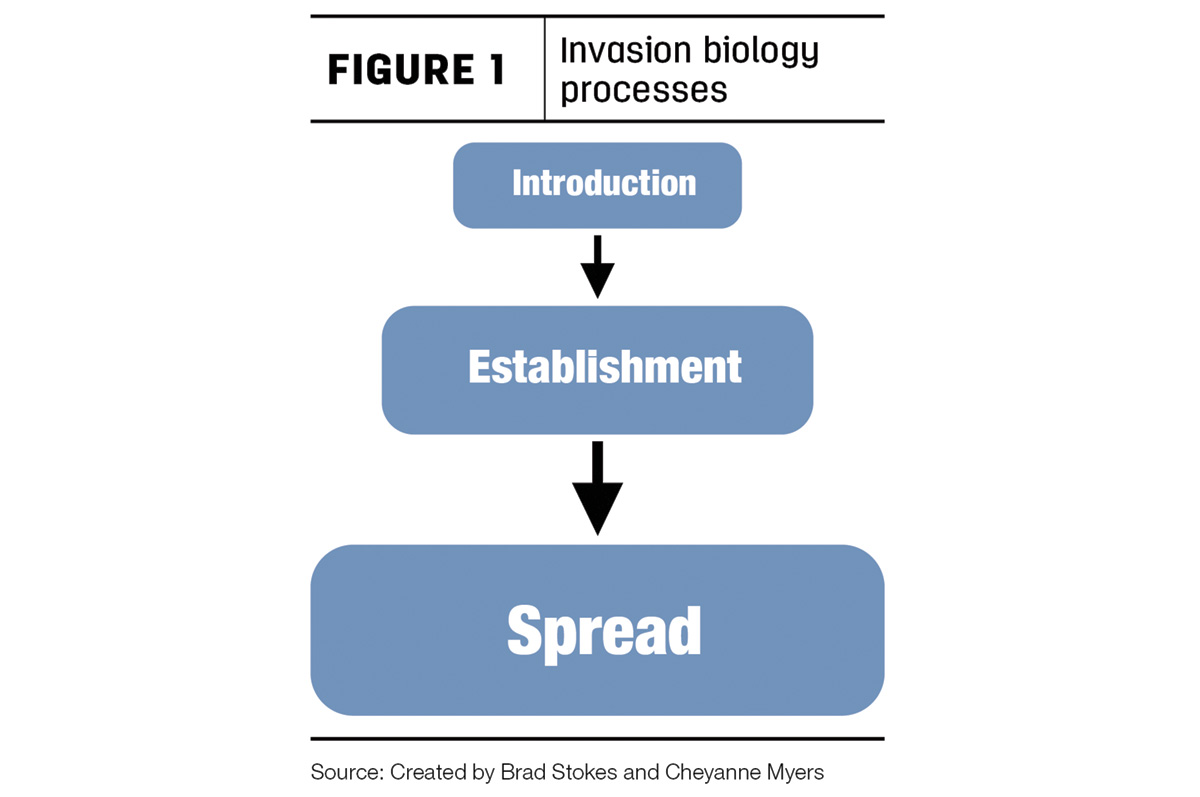Invasive organisms including viruses, virions, bacteria, fungi, nematodes, arthropods, plants/weeds, birds, fish, reptiles, amphibians or mammals could be defined as any organism that is introduced to a new area (range) where they are not normally located geographically.
Invasive organisms can, and often do, cause adverse consequences to their newly introduced range. In terms of the finances of countries, states, regional/local governments spend billions of dollars per year trying to manage, control and/or eradicate invasive organisms.
This entire process has been studied in-depth by biologists and scientists, with this new field designated as invasion biology – the study of invasive organisms in new ranges. Invasion biology first starts with the introduction of an alien species to a new area; it can be done either intentionally or by complete accident.
Phases of invasion biology
Introduction is the first step in any invasion biology process by any non-native organism. Worldwide global commerce is a great example of numerous accidental introductions of invasive organisms; as global trade has expanded over the last few hundred years, so has the introduction, establishment and spread of species around the globe.
During the introduction phase of invasion biology, there are massive geographical barriers that must be overcome; most of these include vast forms or great distances. Classic past examples of this include ballast water from ships. As they loaded their ballast tanks from where their cargo was shipped from, sailed thousands of miles away and reached their new destination, the ships unloaded this ballast water and resulted in hundreds of new species introduced to the Great Lakes waterways.
After the introduction of an invasive organism, then comes the establishment phase. This hypothetical invasive organism must establish itself (and more importantly, in a viable reproducing population) within the new range for the sustainability of the invasive population. This process includes finding an acceptable and viable source of food, refuge site/shelter, mate and ecosystem acceptability or a niche within that ecosystem on which to thrive. Establishment is critical for the last phase of an invasive organism in a new range.
One of the most important processes of invasion biology is the spreading of organisms throughout the new range from the point of introduction. If an invasive organism successfully gets introduced and established but cannot spread, then the question would be: is it a true invasive?
The spread of an invasive organism depends upon the morphological, biological, behavioral and life cycle adaptations of that organism. Inherently, some invasive organisms are more likely to spread vast distances and have wide host ranges or acceptability (generalists), especially if they have the capability of sustained flight or vast movement from meteorological events. If some of these traits are combined with others, such as high fecundity, high reproduction and biological/genotypical plasticity, serious ecological and economic consequences are more likely. When an invasive organism has accomplished introduction, establishment and vastly spread its range in the new ecosystem, often eradication is not feasible and control options are outrageously expensive year to year, sometimes exceeding billions of dollars.

During each of the phases of invasion biology (Figure 1), the impact of that invasive organism may also change as population dynamics fluctuate in the new range as ecological trophic levels. Often, there is a lag phase within invasion biology, and species of concern in new ranges often experience this phase before initial discovery. This is not unusual, as not every citizen inherently knows the local species fauna, nor potentially who to contact if a question were to arise. It’s of no surprise that an invasive species might go unnoticed for years, perhaps in a new range, while the population builds up to economically explosive levels.
Recent discoveries and actions
We bring up invasion biology now, as just last September, the Snake River watershed experienced the discovery of the veliger stage of a highly invasive organism by the Idaho State Department of Agriculture (ISDA) – the quagga mussel. This species was found, surveyed, treated twice, and aquatic surveys will continue in 2024 and beyond. In conjunction, the State of Idaho Legislature’s Joint Finance Appropriations Committee (JFAC) voted on and approved an $11.6 million dollar expenditure dedicated to survey, treatment and fighting off these invasive organisms for fiscal year 2025.
Additionally, several other invasive species of concern should be on the minds of scientists, biologists, ecologists, economists and elected officials from all levels of government. The emerald ash borer, Agrilus planipennis, was recently found (June 30, 2022) near Forest Grove, Oregon. This destructive invasive wood-boring beetle has already caused mass destruction of the ash tree species (fraxinus spp.) and deciduous forests ecosystems of the Midwest, as well as a major threat to horticultural/urban settings where ash trees are commonly planted.
The Japanese beetle, Popillia japonica, is a beautiful scarab beetle with a large host range and has been found in the Treasure Valley since 2012, and even into last year (2023) treatments were being made in Caldwell for eradication in the local area. (2024 treatments are planned.) It is a concern because it is known to have a plant host range to exceed 300 different plant species, including agricultural commodities grown in Idaho, ornamental lawns/shrubs/trees and garden crops. Several species are located on the Invasive Species Program managed by the Idaho State Department of Agriculture.
As an Idahoan, if you have knowledge or concern about reporting potential invasive species, call the ISDA Invasive Species Hotline toll-free at (877) 336-8676. The University of Idaho Extension system has created the Idaho Insect Identification website in addition as a statewide educational and response resource with insect/arthropod identification being led by myself (Brad Stokes, Canyon County) and Jason Thomas (Minidoka County). Let’s keep Idaho Idaho and protect our essential ecological systems we all enjoy and our economic vitality into the future. Invasive organisms of all types have the capability to seriously harm our environment and economy at great scales.



.jpg?t=1687979285&width=640)

.jpg?height=auto&t=1723756374&width=285)


